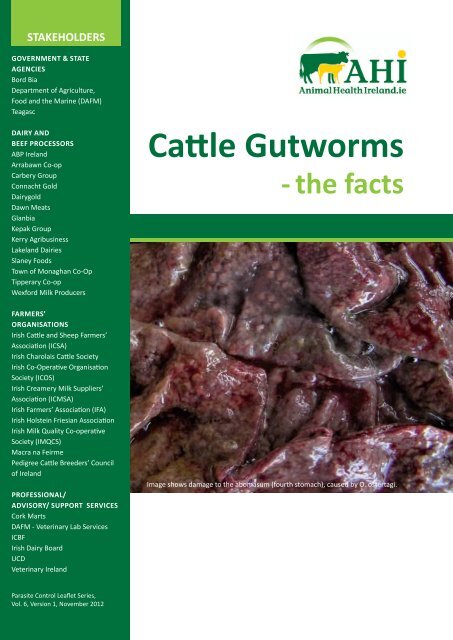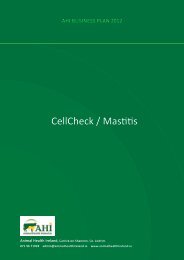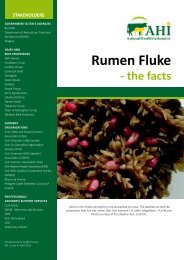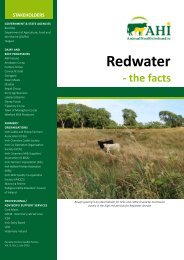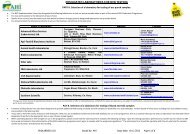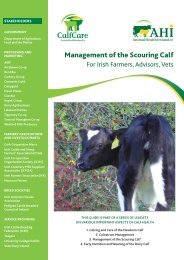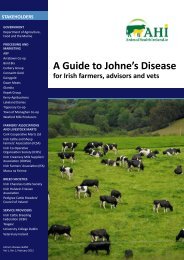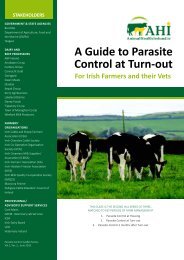Cattle Gutworms - Animal Health Ireland
Cattle Gutworms - Animal Health Ireland
Cattle Gutworms - Animal Health Ireland
Create successful ePaper yourself
Turn your PDF publications into a flip-book with our unique Google optimized e-Paper software.
STAKEHOLDERS<br />
Government & State<br />
aGenCieS<br />
Bord Bia<br />
Department of Agriculture,<br />
Food and the Marine (DAFM)<br />
Teagasc<br />
Dairy anD<br />
Beef ProCeSSorS<br />
ABP <strong>Ireland</strong><br />
Arrabawn Co-op<br />
Carbery Group<br />
Connacht Gold<br />
Dairygold<br />
Dawn Meats<br />
Glanbia<br />
Kepak Group<br />
Kerry Agribusiness<br />
Lakeland Dairies<br />
Slaney Foods<br />
Town of Monaghan Co-Op<br />
Tipperary Co-op<br />
Wexford Milk Producers<br />
farmerS’<br />
orGaniSationS<br />
Irish <strong>Cattle</strong> and Sheep Farmers’<br />
Association (ICSA)<br />
Irish Charolais <strong>Cattle</strong> Society<br />
Irish Co-Operative Organisation<br />
Society (ICOS)<br />
Irish Creamery Milk Suppliers’<br />
Association (ICMSA)<br />
Irish Farmers’ Association (IFA)<br />
Irish Holstein Friesian Association<br />
Irish Milk Quality Co-operative<br />
Society (IMQCS)<br />
Macra na Feirme<br />
Pedigree <strong>Cattle</strong> Breeders’ Council<br />
of <strong>Ireland</strong><br />
ProfeSSional/<br />
aDviSory/ SuPPort ServiCeS<br />
Cork Marts<br />
DAFM - Veterinary Lab Services<br />
ICBF<br />
Irish Dairy Board<br />
UCD<br />
Veterinary <strong>Ireland</strong><br />
Parasite Control Leaflet Series,<br />
Vol. 6, Version 1, November 2012<br />
<strong>Cattle</strong> <strong>Gutworms</strong><br />
- the facts<br />
Image shows damage to the abomasum (fourth stomach), caused by O. ostertagi.
PaGe 2 <strong>Cattle</strong> <strong>Gutworms</strong> - the facts<br />
introduction<br />
There are approximately 20 species of worms, known collectively as gutworms, that live in the intestines and stomach<br />
of cattle. These worms cause the condition known as parasitic gastroenteritis (PGE), which is common in cattle (and<br />
sheep) of all ages and can result in poor thrive and liveweight gain, ill health, poor production and financial losses.<br />
The two most economically important species of worms in <strong>Ireland</strong> are Cooperia oncophora and Ostertagia ostertagi.<br />
C. oncophora O. ostertagi<br />
• It lives in the small intestine.<br />
• It lives in the fourth stomach (abomasum).<br />
• It is the main contributor to faecal egg counts,<br />
certainly up to mid-summer of the first grazing<br />
season (FGS).<br />
• <strong>Animal</strong>s appear to develop an immune response<br />
to this parasite; consequently both intestinal<br />
worm burdens and faecal egg counts tend to<br />
decline towards the end of the FGS and remain low<br />
subsequently.<br />
• This parasite can worsen the effect of O. ostertagi,<br />
particularly in young calves.<br />
• Like Cooperia, infections can be acquired from<br />
turnout in the Spring by ingesting over-wintered<br />
larvae on grass.<br />
• Immunity to Ostertagia takes longer to develop than<br />
in the case of Cooperia and animals are not normally<br />
considered to be immune until they have completed<br />
two full grazing seasons.<br />
• Adult animals are commonly infected with O.<br />
ostertagi, though the worm burdens are typically<br />
lower than in calves.<br />
the importance of parasitic gastroenteritis (PGe) in cattle<br />
Young animals (particularly calves) may develop severe clinical infections that result in a reduction in feed intake,<br />
diarrhoea and rapid loss of condition. However, more commonly, PGE is present subclinically, which means that<br />
it may not be easily detected and that farmers and veterinary practitioners may therefore be unaware of the<br />
associated production losses.<br />
Gutworm-related production losses are often due to a loss of appetite from a sub-clinical PGE, which means that animals<br />
simply do not eat enough to support higher levels of production. Table 1 highlights the negative effects that subclinical<br />
PGE can have on different animal classes. Monitoring animals performance throughout the season (weight gain and<br />
production) and using suitable diagnostic tests (Table 2) is essential to establish a strategy for control of gutworms.
PaGe 3 <strong>Cattle</strong> <strong>Gutworms</strong> - the facts<br />
table 1. Production losses associated with Sub-clinical Parasitic Gastroenteritis<br />
<strong>Animal</strong> type Effects on production<br />
First grazing season (FGS) dairy calves<br />
Housed cattle<br />
Second grazing season cattle<br />
Dairy cows and first calved dairy heifers<br />
Beef cows and first calved beef heifers<br />
life cycle<br />
Figure 1: Gutworm life cycle<br />
Reduced growth rate<br />
Lower Feed Conversion Efficiency<br />
Reduced growth rate<br />
Delay in puberty & reduced conception rates in<br />
replacement heifers<br />
Reduced in-calf rate in heifers<br />
Loss of carcass yield and quality<br />
Decreased milk yield<br />
Longer calving to conception interval<br />
Decreased in-calf rates<br />
Decreased milk yield<br />
Longer calving to conception interval<br />
Lower calf weaning weight<br />
Decreased in-calf rates<br />
The lifecycle of these worms can be considered in two phases - inside the host animal and outside. Figure 1 shows<br />
the whole life cycle. Figure 2 highlights the stages of the parasite development within the host animal, and Figure<br />
3 focuses on the development stages outside of the animal.
PaGe 4 <strong>Cattle</strong> <strong>Gutworms</strong> - the facts<br />
the parasitic stages inside the animal<br />
After the infective L3 larvae have been ingested with grass, they lose their outer covering (exsheath) in the rumen,<br />
then move to their chosen sites, which for Ostertagia are the glands of the abomasum, and for Cooperia, the<br />
tissue of the small intestine. There, the worms develop and emerge as adults in a period of 15-18 days in the case<br />
of C. oncophora and 18-21 days in the case of O.ostertagi after which they start laying eggs (Figure 2). Generally<br />
for planning worm control programmes and monitoring the effect of these through dung sampling, a three week<br />
interval between initial infection and the appearance of eggs in the dung can be expected.<br />
A change in the standard life cycle in Ostertagia occurs in the autumn and over winter. Larvae acquired during<br />
the latter part of the grazing season, instead of proceeding through the normal development to adult worms,<br />
enter a period of hibernation in the gutwall. Development resumes after several months, towards the end of the<br />
winter, and the emergence of the larvae from the gutwall at this time can result in severe clinical disease in some<br />
animals - a condition known as type II Ostertagiosis. The risk of this disease can be virtually eliminated through the<br />
administration of an effective anthelmintic (wormer) at housing (see Table 3).<br />
figure 2. Ostertagia ostertagi life Cycle; transmission and Parasitic stages<br />
In Rumen<br />
l3 exsheath<br />
In Abomasum<br />
l3 to egg laying adult<br />
inhibited larvae to<br />
egg laying adult<br />
(type ii disease)<br />
2-6 hours<br />
21 days (grazing season)<br />
Up to 6 months<br />
larvae (l3) Ingested while grazing
PaGe 5 <strong>Cattle</strong> <strong>Gutworms</strong> - the facts<br />
the parasitic stages outside the animal<br />
Worm eggs are excreted in the dung, hatch and then undergo further development within the dung pat (Figure 3).<br />
The free-living stages of both O. ostertagi and C. oncophora are very similar. Hatching and larval development are<br />
mainly dependent on temperature, although moisture is also required as these stages are susceptible to drying out.<br />
It can take up to 3 weeks for the eggs to develop to infective larvae under field conditions over the period of April<br />
to October, while development during the winter and early spring takes longer. The larvae are hardy and able to<br />
withstand environmental and temperature fluctuations which allows them to survive in the soil in the long term. O.<br />
ostertagi and C. oncophora L3 larvae can be recovered from pasture up to two years after deposition in the dung,<br />
although their numbers are greatly reduced after one year.<br />
Studies have shown that most larvae move no more than five centimetres on grass, with the majority of larvae being<br />
found in the lower five centimetres of the sward. However, because grass heights can commonly range between five<br />
and eight centimetres, there is plenty of opportunity for stock to ingest infective larvae, particularly if they graze<br />
close when grazing pressure is high.<br />
Rainfall is important in facilitating movement of larvae away from dung and onto pasture. An initial wetting and<br />
softening of the dry crust, which typically forms on dung pats, is followed by the infective larvae being splashed<br />
out in droplets. This can account for 90% of the movement of larvae from the pat to the pasture and larvae can be<br />
found up to 90 cm from the pat. Spread of larvae beyond this range takes place passively through water flow and<br />
transport hosts, including earthworms, insects, birds and cattle themselves (viable infective L3 larvae can be found<br />
in samples of encrusted faeces on the feet and limbs of grazing cattle).<br />
figure 3. The worm larvae that develop in the dung are a source of infective larvae for grazing animals<br />
Egg<br />
Larvae (L1)<br />
Infective (L3)<br />
temperature (1-2 week)<br />
active larval movement<br />
(up to 5 cm) in moisture<br />
Larvae (L2)<br />
Larvae (L3)<br />
Passive larval<br />
movement (up<br />
to 90 cm) due<br />
to rain splash<br />
Infective (L3)
PaGe 6 <strong>Cattle</strong> <strong>Gutworms</strong> - the facts<br />
management Systems<br />
The Irish spring-calving pattern and extended grazing seasons determine the patterns of worm infection and the<br />
control options that can be used. For control programmes, different approaches are taken with first grazing season<br />
and second grazing season animals. Detailed information on the treatment and control of stomach worms is<br />
available within the AHI Parasite Control Leaflet Series ‘A Guide to Parasite Control at Housing’, ‘A Guide to Parasite<br />
Control at Turn-Out’ and ‘A Guide to Parasite Control at Grazing’. These leaflets are available on the AHI website<br />
www.animalhealthireland.ie.<br />
Dairy farms<br />
Larvae that have survived over winter in grass may cause disease in cattle following turn-out in springtime. At this<br />
time, the numbers of larvae will have declined from the levels present at housing the previous autumn, but because<br />
the fields may have been ungrazed by cattle for a relatively short time (2 to 3 months), over-wintered larval survival<br />
may be relatively high (compared to systems when cattle are housed for up to 6 months over winter). Hence,<br />
calves and older animals may be exposed to infection early in the year. If uncontrolled, ingested worms will go on<br />
to complete their life cycle, produce more eggs and further contaminate the pasture in a cyclical fashion, so that<br />
after a couple of months, pastures can be highly contaminated and the grazing animals consequently at risk of high<br />
levels of infection. Newly re-seeded pastures or aftergrass that have had no cattle for at least 6 months should pose<br />
a much lower threat and should be used for the most susceptible animals (e.g. first grazing season dairy calves).<br />
Strategic grazing management<br />
will help in gutworm control on<br />
dairy farms
PaGe 7 <strong>Cattle</strong> <strong>Gutworms</strong> - the facts<br />
Beef farms<br />
In spring-calving beef breeding herds the cows are typically immune and excrete low concentrations (
Parasite Control Leaflet Series, Vol. 6, Ver 1, November 2012<br />
PaGe 8 <strong>Cattle</strong> <strong>Gutworms</strong> - the facts<br />
table 2. technical information for diagnostic sampling of <strong>Gutworms</strong><br />
Stock Class Sample Type No. of <strong>Animal</strong>s Sampled Tests<br />
First grazing season calves Faeces<br />
10-15*<br />
Faecal examination for<br />
worm and fluke eggs and<br />
lungworm larvae<br />
In-calf heifers (Second GS)<br />
Adult cows<br />
*Faecal samples from individual animals can be pooled in the laboratory, thereby reducing costs (though losing some valuable information<br />
on individual values and variability).<br />
table 3. treatment options for <strong>Gutworms</strong><br />
Parasite <strong>Animal</strong> Age Significance Treatments<br />
Stomach & other gut All ages, immunity is typically Suboptimal performance Benzimidazoles*<br />
worms<br />
less in first grazing season<br />
Endectocides*<br />
animals compared to second<br />
Levamisole* only effective<br />
grazing season animals.<br />
In turn, immunity is less<br />
in second grazing season<br />
animals than in adults.<br />
against adult worms<br />
Inhibited larvae of stomach<br />
& other gut worms (e.g.<br />
Ostertagia ostertagi)<br />
*Available in combination products<br />
teCHniCal WorKinG GrouP: michael Doherty (Chairperson) - UCD School<br />
of Veterinary Medicine, mícheál Casey - DAFM Regional Veterinary Laboratory,<br />
Backweston, Bosco Cowley - MSD <strong>Animal</strong> <strong>Health</strong>, martin Danaher - Teagasc<br />
Food Research Centre Ashtown, theo de Waal - UCD School of Veterinary<br />
Medicine, andrew Forbes - Merial, Lyon, France, maura langan - Norbrook<br />
Laboratories, Barbara Good - Teagasc, Athenry, John Gilmore - Veterinary<br />
Practitioner, fintan Graham - Veterinary Practitioner, ian Hogan - DAFM,<br />
Veterinary Laboratory Services, Grace mulcahy - UCD School of Veterinary<br />
Medicine, June fanning - Central Veterinary Research Laboratory, Backweston,<br />
Donal Toolan - DAFM Regio nal Veterinary Laboratory, Kilkenny.<br />
teCHniCal WorKinG GrouP raPPorteur: fionnuala malone, <strong>Animal</strong><br />
<strong>Health</strong> <strong>Ireland</strong><br />
illuStrator: Gerard Crowley<br />
Blood<br />
Faeces<br />
Blood<br />
Bulk milk<br />
All ages<br />
Peer revieW By: Professor Bob Hanna, Veterinary Sciences Division, Agri-Food and<br />
Biosciences Institute, Stormont, Dr. Jason Barley, Veterinary Sciences Division, Agri-<br />
Food and Biosciences Institute Stormont. Professor mike taylor, European Veterinary<br />
Specialist in Veterinary Parasitology, Veterinary Director, VparST Limited.<br />
10-15<br />
10-15*<br />
10-15<br />
Ostertagiosis Type II disease<br />
<strong>Animal</strong> <strong>Health</strong> <strong>Ireland</strong>, Main Street, Carrick-on-Shannon, Co. Leitrim<br />
Phone 071 9671928<br />
Email admin@animalhealthireland.ie<br />
Web www.animalhealthireland.ie<br />
1<br />
Plasma pepsinogen<br />
Stomach worm<br />
Faecal egg count<br />
Fluke<br />
ELISA<br />
Stomach worm<br />
ELISA<br />
Stomach worm Fluke<br />
Lungworm?<br />
Some Benzimidazoles*<br />
(check label) Endectocides*<br />
N.B. levamisole not<br />
effective<br />
intelleCtual ProPerty: All images contained in this leaflet are the<br />
property of AHI, or have been included with the permission of the owner.<br />
Please seek permission from AHI if you wish to use these images and provide<br />
the correct attribution of ownership when reproducing them. If reusing any<br />
other material in this leaflet, please attribute AHI as the source.<br />
Front cover abomasum image is courtesy of Regional Veterinary Laboratories,<br />
Dept of Agriculture, Food & Marine.<br />
imPortant notiCe — DiSClaimer: While every reasonable effort has been<br />
made to ensure the accuracy of the contents of this leaflet at the time<br />
of printing, no representation or guarantee is given, whether by AHI, its<br />
employees, subcontractors, agents, distributors or any other person, that<br />
the contents of this information leaflet are comprehensive, up to date, or<br />
free from error or omissions, nor that the advice provided is appropriate<br />
in every particular circumstance. The contents of this information leaflet<br />
are not intended to be a substitute for appropriate direct advice from your<br />
veterinary practitioner. Appropriate veterinary advice should be taken before<br />
taking or refraining from taking action in relation to the animal disease dealt<br />
with in this information leaflet.


